Human Capital Development in Tourism: Challenges and Strategies Report
VerifiedAdded on 2022/11/13
|9
|2591
|264
Report
AI Summary
This report delves into the human capital development challenges within the Canadian tourism sector, particularly focusing on labour shortages. It identifies key HR challenges, including talent acquisition and retention, demographic shifts, and the evolving needs of the workforce. The report examines strategies employed by HR professionals to overcome these obstacles, such as employee engagement initiatives, competitive benefits packages (retirement and healthcare), and the use of technology. Furthermore, it explores trends like attractive workplace culture and employee recognition programs to enhance employee appeal and retention. The report highlights the benefits of implementing these strategies, including reduced turnover, the creation of company experts, increased productivity, and improved customer experiences. Overall, the report offers insights into the complexities of HR management within the tourism industry and provides practical solutions for sustainable growth.
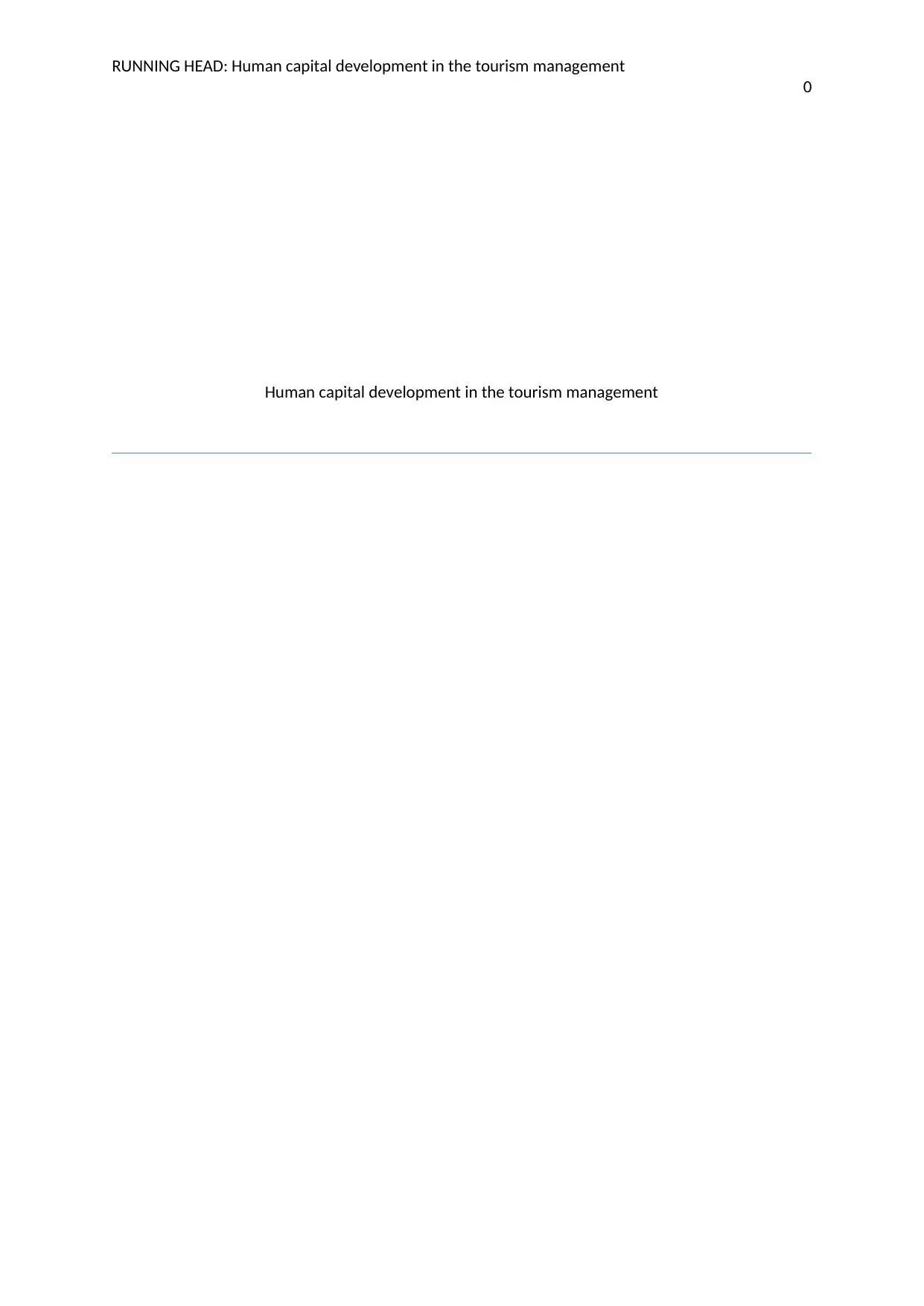
RUNNING HEAD: Human capital development in the tourism management
0
Human capital development in the tourism management
0
Human capital development in the tourism management
Paraphrase This Document
Need a fresh take? Get an instant paraphrase of this document with our AI Paraphraser
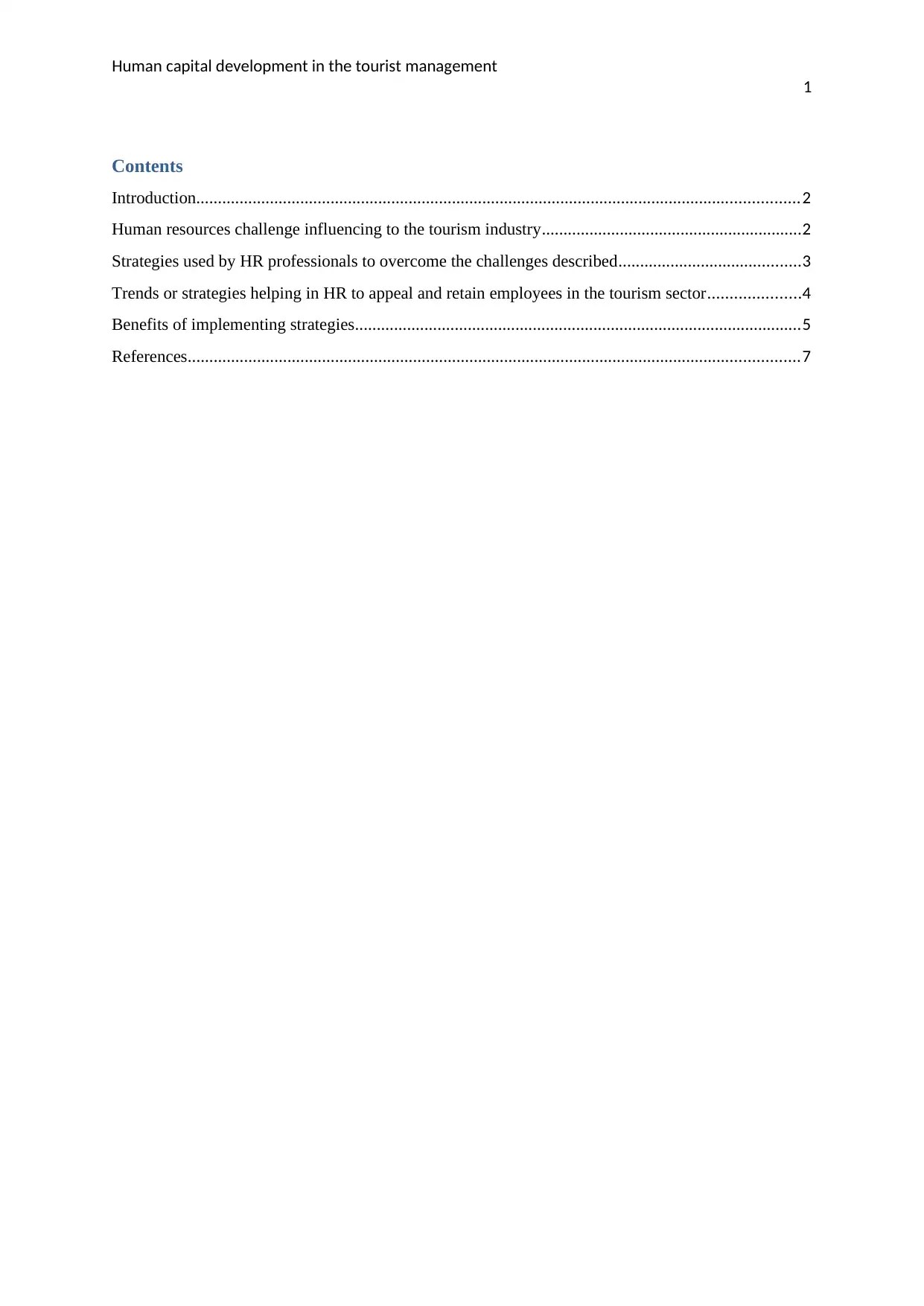
Human capital development in the tourist management
1
Contents
Introduction...........................................................................................................................................2
Human resources challenge influencing to the tourism industry............................................................2
Strategies used by HR professionals to overcome the challenges described..........................................3
Trends or strategies helping in HR to appeal and retain employees in the tourism sector.....................4
Benefits of implementing strategies.......................................................................................................5
References.............................................................................................................................................7
1
Contents
Introduction...........................................................................................................................................2
Human resources challenge influencing to the tourism industry............................................................2
Strategies used by HR professionals to overcome the challenges described..........................................3
Trends or strategies helping in HR to appeal and retain employees in the tourism sector.....................4
Benefits of implementing strategies.......................................................................................................5
References.............................................................................................................................................7
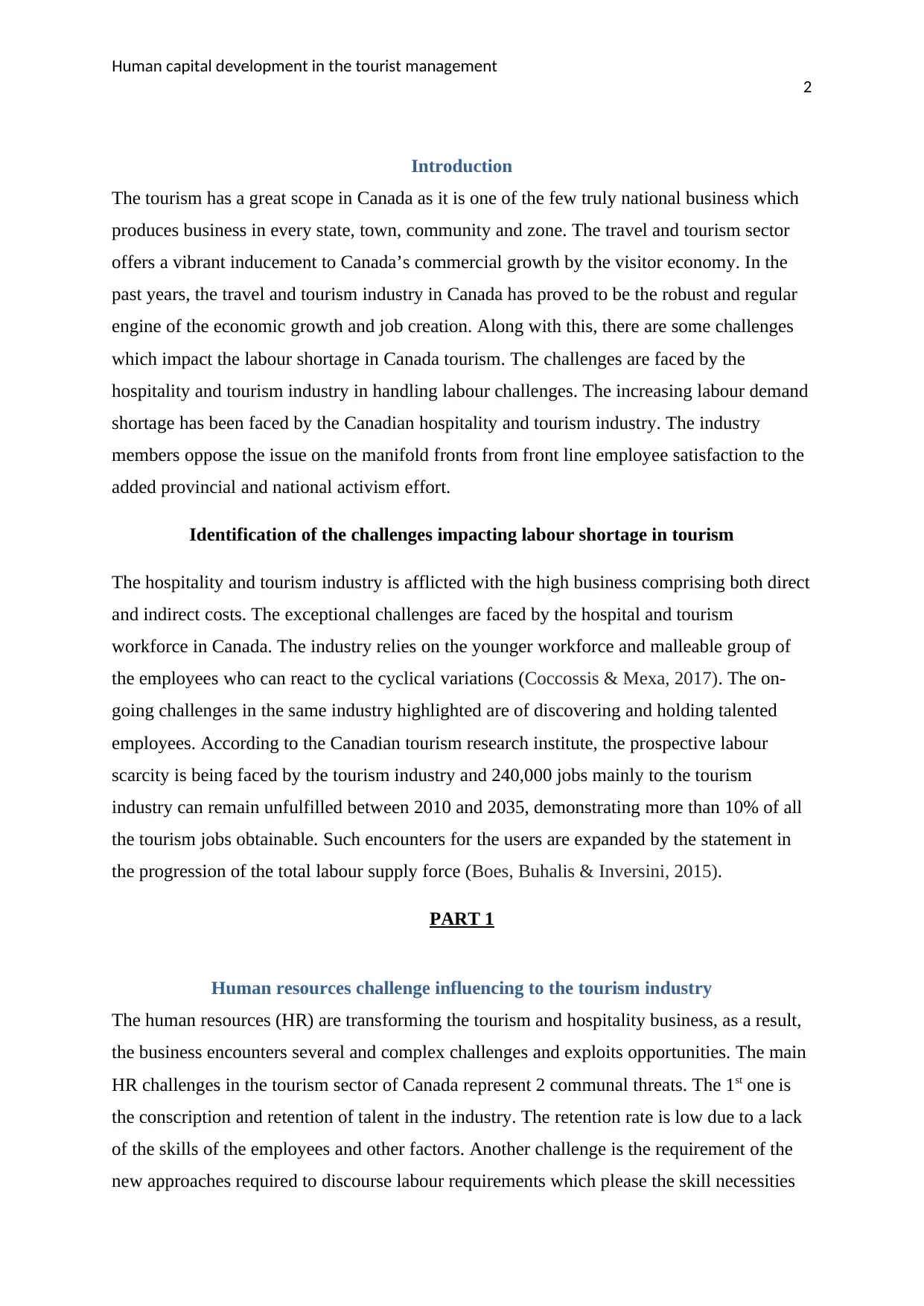
Human capital development in the tourist management
2
Introduction
The tourism has a great scope in Canada as it is one of the few truly national business which
produces business in every state, town, community and zone. The travel and tourism sector
offers a vibrant inducement to Canada’s commercial growth by the visitor economy. In the
past years, the travel and tourism industry in Canada has proved to be the robust and regular
engine of the economic growth and job creation. Along with this, there are some challenges
which impact the labour shortage in Canada tourism. The challenges are faced by the
hospitality and tourism industry in handling labour challenges. The increasing labour demand
shortage has been faced by the Canadian hospitality and tourism industry. The industry
members oppose the issue on the manifold fronts from front line employee satisfaction to the
added provincial and national activism effort.
Identification of the challenges impacting labour shortage in tourism
The hospitality and tourism industry is afflicted with the high business comprising both direct
and indirect costs. The exceptional challenges are faced by the hospital and tourism
workforce in Canada. The industry relies on the younger workforce and malleable group of
the employees who can react to the cyclical variations (Coccossis & Mexa, 2017). The on-
going challenges in the same industry highlighted are of discovering and holding talented
employees. According to the Canadian tourism research institute, the prospective labour
scarcity is being faced by the tourism industry and 240,000 jobs mainly to the tourism
industry can remain unfulfilled between 2010 and 2035, demonstrating more than 10% of all
the tourism jobs obtainable. Such encounters for the users are expanded by the statement in
the progression of the total labour supply force (Boes, Buhalis & Inversini, 2015).
PART 1
Human resources challenge influencing to the tourism industry
The human resources (HR) are transforming the tourism and hospitality business, as a result,
the business encounters several and complex challenges and exploits opportunities. The main
HR challenges in the tourism sector of Canada represent 2 communal threats. The 1st one is
the conscription and retention of talent in the industry. The retention rate is low due to a lack
of the skills of the employees and other factors. Another challenge is the requirement of the
new approaches required to discourse labour requirements which please the skill necessities
2
Introduction
The tourism has a great scope in Canada as it is one of the few truly national business which
produces business in every state, town, community and zone. The travel and tourism sector
offers a vibrant inducement to Canada’s commercial growth by the visitor economy. In the
past years, the travel and tourism industry in Canada has proved to be the robust and regular
engine of the economic growth and job creation. Along with this, there are some challenges
which impact the labour shortage in Canada tourism. The challenges are faced by the
hospitality and tourism industry in handling labour challenges. The increasing labour demand
shortage has been faced by the Canadian hospitality and tourism industry. The industry
members oppose the issue on the manifold fronts from front line employee satisfaction to the
added provincial and national activism effort.
Identification of the challenges impacting labour shortage in tourism
The hospitality and tourism industry is afflicted with the high business comprising both direct
and indirect costs. The exceptional challenges are faced by the hospital and tourism
workforce in Canada. The industry relies on the younger workforce and malleable group of
the employees who can react to the cyclical variations (Coccossis & Mexa, 2017). The on-
going challenges in the same industry highlighted are of discovering and holding talented
employees. According to the Canadian tourism research institute, the prospective labour
scarcity is being faced by the tourism industry and 240,000 jobs mainly to the tourism
industry can remain unfulfilled between 2010 and 2035, demonstrating more than 10% of all
the tourism jobs obtainable. Such encounters for the users are expanded by the statement in
the progression of the total labour supply force (Boes, Buhalis & Inversini, 2015).
PART 1
Human resources challenge influencing to the tourism industry
The human resources (HR) are transforming the tourism and hospitality business, as a result,
the business encounters several and complex challenges and exploits opportunities. The main
HR challenges in the tourism sector of Canada represent 2 communal threats. The 1st one is
the conscription and retention of talent in the industry. The retention rate is low due to a lack
of the skills of the employees and other factors. Another challenge is the requirement of the
new approaches required to discourse labour requirements which please the skill necessities
⊘ This is a preview!⊘
Do you want full access?
Subscribe today to unlock all pages.

Trusted by 1+ million students worldwide
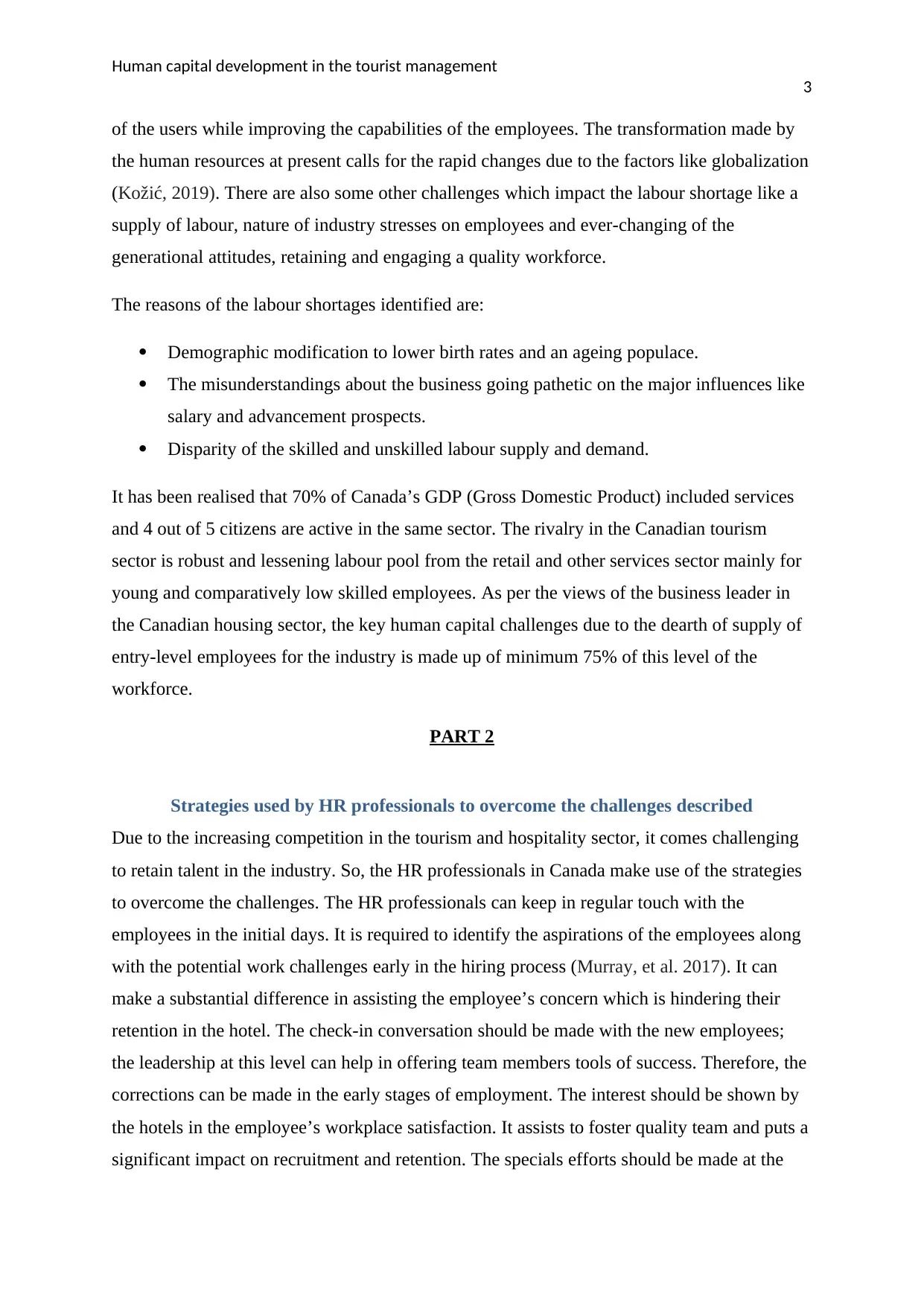
Human capital development in the tourist management
3
of the users while improving the capabilities of the employees. The transformation made by
the human resources at present calls for the rapid changes due to the factors like globalization
(Kožić, 2019). There are also some other challenges which impact the labour shortage like a
supply of labour, nature of industry stresses on employees and ever-changing of the
generational attitudes, retaining and engaging a quality workforce.
The reasons of the labour shortages identified are:
Demographic modification to lower birth rates and an ageing populace.
The misunderstandings about the business going pathetic on the major influences like
salary and advancement prospects.
Disparity of the skilled and unskilled labour supply and demand.
It has been realised that 70% of Canada’s GDP (Gross Domestic Product) included services
and 4 out of 5 citizens are active in the same sector. The rivalry in the Canadian tourism
sector is robust and lessening labour pool from the retail and other services sector mainly for
young and comparatively low skilled employees. As per the views of the business leader in
the Canadian housing sector, the key human capital challenges due to the dearth of supply of
entry-level employees for the industry is made up of minimum 75% of this level of the
workforce.
PART 2
Strategies used by HR professionals to overcome the challenges described
Due to the increasing competition in the tourism and hospitality sector, it comes challenging
to retain talent in the industry. So, the HR professionals in Canada make use of the strategies
to overcome the challenges. The HR professionals can keep in regular touch with the
employees in the initial days. It is required to identify the aspirations of the employees along
with the potential work challenges early in the hiring process (Murray, et al. 2017). It can
make a substantial difference in assisting the employee’s concern which is hindering their
retention in the hotel. The check-in conversation should be made with the new employees;
the leadership at this level can help in offering team members tools of success. Therefore, the
corrections can be made in the early stages of employment. The interest should be shown by
the hotels in the employee’s workplace satisfaction. It assists to foster quality team and puts a
significant impact on recruitment and retention. The specials efforts should be made at the
3
of the users while improving the capabilities of the employees. The transformation made by
the human resources at present calls for the rapid changes due to the factors like globalization
(Kožić, 2019). There are also some other challenges which impact the labour shortage like a
supply of labour, nature of industry stresses on employees and ever-changing of the
generational attitudes, retaining and engaging a quality workforce.
The reasons of the labour shortages identified are:
Demographic modification to lower birth rates and an ageing populace.
The misunderstandings about the business going pathetic on the major influences like
salary and advancement prospects.
Disparity of the skilled and unskilled labour supply and demand.
It has been realised that 70% of Canada’s GDP (Gross Domestic Product) included services
and 4 out of 5 citizens are active in the same sector. The rivalry in the Canadian tourism
sector is robust and lessening labour pool from the retail and other services sector mainly for
young and comparatively low skilled employees. As per the views of the business leader in
the Canadian housing sector, the key human capital challenges due to the dearth of supply of
entry-level employees for the industry is made up of minimum 75% of this level of the
workforce.
PART 2
Strategies used by HR professionals to overcome the challenges described
Due to the increasing competition in the tourism and hospitality sector, it comes challenging
to retain talent in the industry. So, the HR professionals in Canada make use of the strategies
to overcome the challenges. The HR professionals can keep in regular touch with the
employees in the initial days. It is required to identify the aspirations of the employees along
with the potential work challenges early in the hiring process (Murray, et al. 2017). It can
make a substantial difference in assisting the employee’s concern which is hindering their
retention in the hotel. The check-in conversation should be made with the new employees;
the leadership at this level can help in offering team members tools of success. Therefore, the
corrections can be made in the early stages of employment. The interest should be shown by
the hotels in the employee’s workplace satisfaction. It assists to foster quality team and puts a
significant impact on recruitment and retention. The specials efforts should be made at the
Paraphrase This Document
Need a fresh take? Get an instant paraphrase of this document with our AI Paraphraser
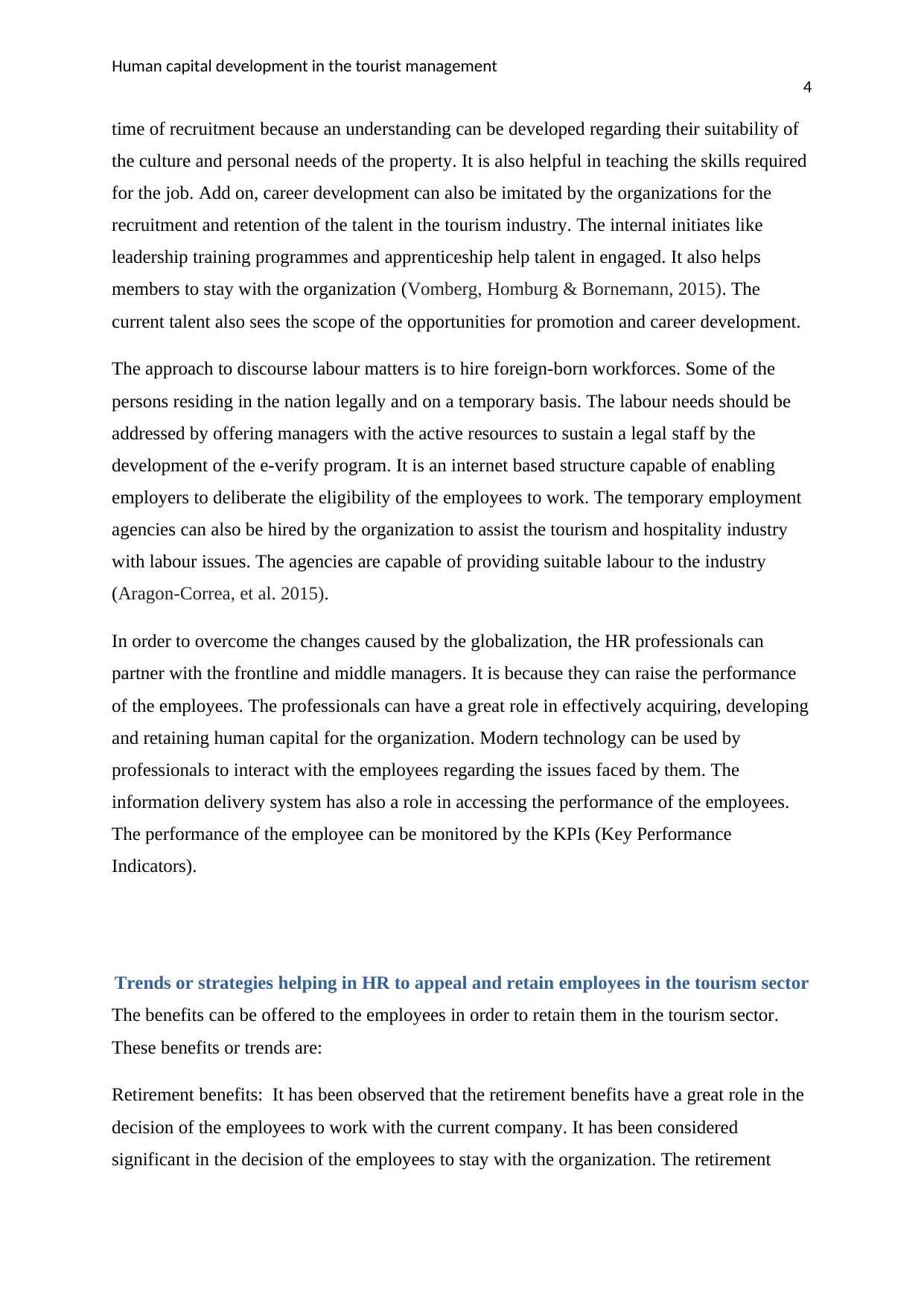
Human capital development in the tourist management
4
time of recruitment because an understanding can be developed regarding their suitability of
the culture and personal needs of the property. It is also helpful in teaching the skills required
for the job. Add on, career development can also be imitated by the organizations for the
recruitment and retention of the talent in the tourism industry. The internal initiates like
leadership training programmes and apprenticeship help talent in engaged. It also helps
members to stay with the organization (Vomberg, Homburg & Bornemann, 2015). The
current talent also sees the scope of the opportunities for promotion and career development.
The approach to discourse labour matters is to hire foreign-born workforces. Some of the
persons residing in the nation legally and on a temporary basis. The labour needs should be
addressed by offering managers with the active resources to sustain a legal staff by the
development of the e-verify program. It is an internet based structure capable of enabling
employers to deliberate the eligibility of the employees to work. The temporary employment
agencies can also be hired by the organization to assist the tourism and hospitality industry
with labour issues. The agencies are capable of providing suitable labour to the industry
(Aragon-Correa, et al. 2015).
In order to overcome the changes caused by the globalization, the HR professionals can
partner with the frontline and middle managers. It is because they can raise the performance
of the employees. The professionals can have a great role in effectively acquiring, developing
and retaining human capital for the organization. Modern technology can be used by
professionals to interact with the employees regarding the issues faced by them. The
information delivery system has also a role in accessing the performance of the employees.
The performance of the employee can be monitored by the KPIs (Key Performance
Indicators).
Trends or strategies helping in HR to appeal and retain employees in the tourism sector
The benefits can be offered to the employees in order to retain them in the tourism sector.
These benefits or trends are:
Retirement benefits: It has been observed that the retirement benefits have a great role in the
decision of the employees to work with the current company. It has been considered
significant in the decision of the employees to stay with the organization. The retirement
4
time of recruitment because an understanding can be developed regarding their suitability of
the culture and personal needs of the property. It is also helpful in teaching the skills required
for the job. Add on, career development can also be imitated by the organizations for the
recruitment and retention of the talent in the tourism industry. The internal initiates like
leadership training programmes and apprenticeship help talent in engaged. It also helps
members to stay with the organization (Vomberg, Homburg & Bornemann, 2015). The
current talent also sees the scope of the opportunities for promotion and career development.
The approach to discourse labour matters is to hire foreign-born workforces. Some of the
persons residing in the nation legally and on a temporary basis. The labour needs should be
addressed by offering managers with the active resources to sustain a legal staff by the
development of the e-verify program. It is an internet based structure capable of enabling
employers to deliberate the eligibility of the employees to work. The temporary employment
agencies can also be hired by the organization to assist the tourism and hospitality industry
with labour issues. The agencies are capable of providing suitable labour to the industry
(Aragon-Correa, et al. 2015).
In order to overcome the changes caused by the globalization, the HR professionals can
partner with the frontline and middle managers. It is because they can raise the performance
of the employees. The professionals can have a great role in effectively acquiring, developing
and retaining human capital for the organization. Modern technology can be used by
professionals to interact with the employees regarding the issues faced by them. The
information delivery system has also a role in accessing the performance of the employees.
The performance of the employee can be monitored by the KPIs (Key Performance
Indicators).
Trends or strategies helping in HR to appeal and retain employees in the tourism sector
The benefits can be offered to the employees in order to retain them in the tourism sector.
These benefits or trends are:
Retirement benefits: It has been observed that the retirement benefits have a great role in the
decision of the employees to work with the current company. It has been considered
significant in the decision of the employees to stay with the organization. The retirement

Human capital development in the tourist management
5
benefits are regarded as substantial drivers of both recruitment and employee retention. The
retirement benefits uniquely incentivize to the long term employment (Boes, Buhalis &
Inversini, 2016). The restaurants, hotels and other organizations in the hospitality sector can
make use of the employer match along with the incentivizing employees to retain within the
organization through the retirement policy. When the employees came to know that the
organization shows interest in securing their financial future then they are more anticipated to
stick around and give their best to the organization.
Health care benefits: The healthcare benefits are greatly important in warding off employee
turnover. The health care benefits are considered as a significant factor by the employees
when they make the decision to work with the organization or when they decide to stay for a
long time with the organization (Oliveira & Panyik, 2015). The medical costs are increasing
day by days, when the employees came to know that their future is in the mind of the tourism
sector they are likely to spend more years in the organization as it can lead to the greater
savings of the employees.
An attractive hospitality culture: The hotels as a part of the tourism sector are required to
build a culture which is attractive enough to engage employees in the organization. The more
engagement of the employees within the organization leads to more employee retention. It
even leads to high revenue growth. An engaging culture has an effective role in the success of
the restaurants, hotels and other organizations in the tourism and hospitality sector
(Moscardo, et al. 2017).
Employee recognition: The employees who get to be recognized by the organization are
likely to above and beyond that. No recognition leads to the little motivation to work and stay
for a long time in the organization. It has been observed that the lack of recognition even
leads employees to quit the organization. Employee recognition can stand as a competitive
advantage for the organization (Meyer & Xin, 2018). The employees can be recognized by
offering appreciation letters by the senior supervisors and managers.
Benefits of implementing strategies
The implementation of the strategies is likely to benefit the tourism and hospitality sector by
Reducing the turnover hassle: The employee turnover is a general aspect of any business, but
high turnover can lead to the hassle. The employees leaving the organization take a chunk of
the time of the organization along with the resources (Marler & Parry, 2016). But the
5
benefits are regarded as substantial drivers of both recruitment and employee retention. The
retirement benefits uniquely incentivize to the long term employment (Boes, Buhalis &
Inversini, 2016). The restaurants, hotels and other organizations in the hospitality sector can
make use of the employer match along with the incentivizing employees to retain within the
organization through the retirement policy. When the employees came to know that the
organization shows interest in securing their financial future then they are more anticipated to
stick around and give their best to the organization.
Health care benefits: The healthcare benefits are greatly important in warding off employee
turnover. The health care benefits are considered as a significant factor by the employees
when they make the decision to work with the organization or when they decide to stay for a
long time with the organization (Oliveira & Panyik, 2015). The medical costs are increasing
day by days, when the employees came to know that their future is in the mind of the tourism
sector they are likely to spend more years in the organization as it can lead to the greater
savings of the employees.
An attractive hospitality culture: The hotels as a part of the tourism sector are required to
build a culture which is attractive enough to engage employees in the organization. The more
engagement of the employees within the organization leads to more employee retention. It
even leads to high revenue growth. An engaging culture has an effective role in the success of
the restaurants, hotels and other organizations in the tourism and hospitality sector
(Moscardo, et al. 2017).
Employee recognition: The employees who get to be recognized by the organization are
likely to above and beyond that. No recognition leads to the little motivation to work and stay
for a long time in the organization. It has been observed that the lack of recognition even
leads employees to quit the organization. Employee recognition can stand as a competitive
advantage for the organization (Meyer & Xin, 2018). The employees can be recognized by
offering appreciation letters by the senior supervisors and managers.
Benefits of implementing strategies
The implementation of the strategies is likely to benefit the tourism and hospitality sector by
Reducing the turnover hassle: The employee turnover is a general aspect of any business, but
high turnover can lead to the hassle. The employees leaving the organization take a chunk of
the time of the organization along with the resources (Marler & Parry, 2016). But the
⊘ This is a preview!⊘
Do you want full access?
Subscribe today to unlock all pages.

Trusted by 1+ million students worldwide
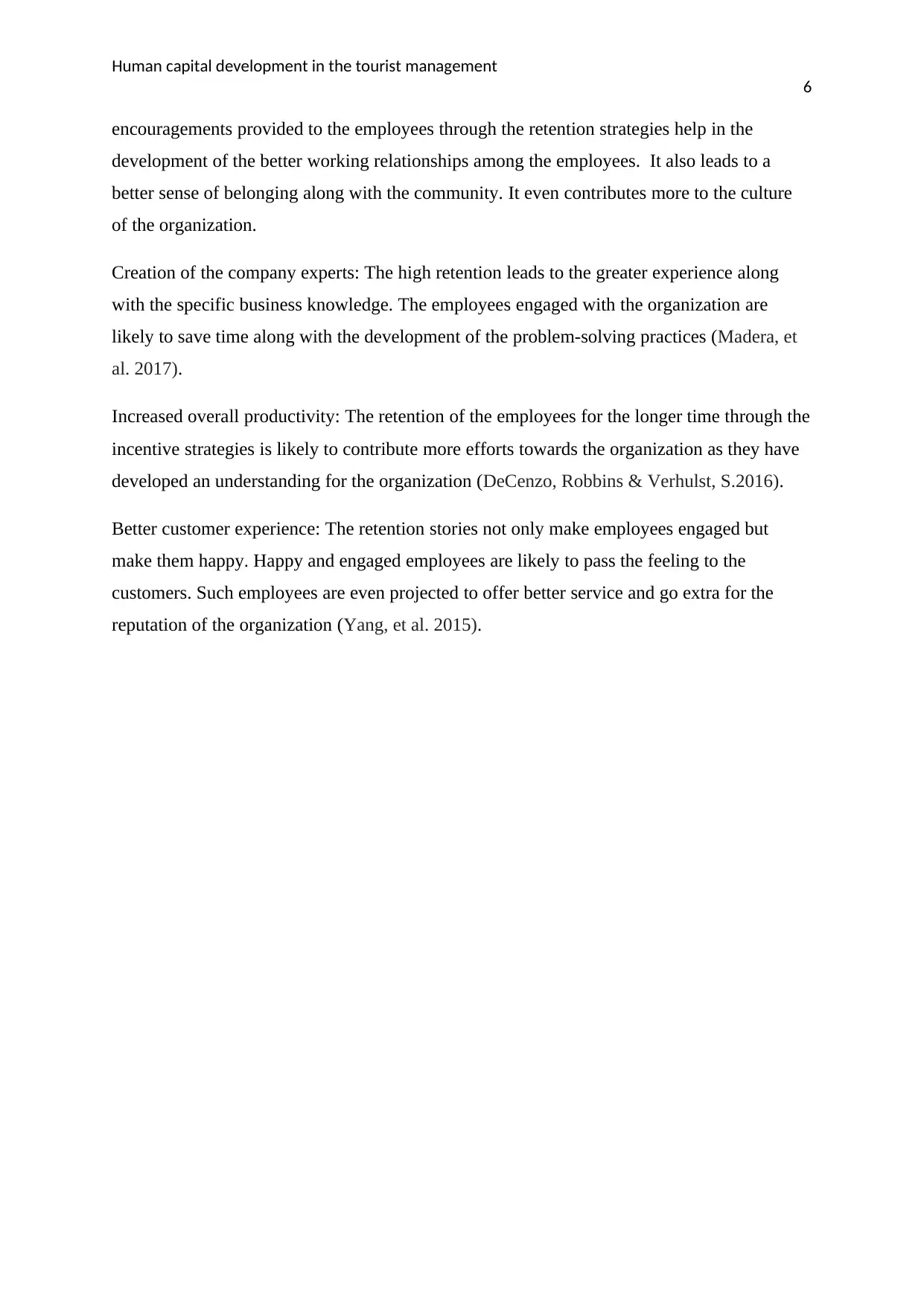
Human capital development in the tourist management
6
encouragements provided to the employees through the retention strategies help in the
development of the better working relationships among the employees. It also leads to a
better sense of belonging along with the community. It even contributes more to the culture
of the organization.
Creation of the company experts: The high retention leads to the greater experience along
with the specific business knowledge. The employees engaged with the organization are
likely to save time along with the development of the problem-solving practices (Madera, et
al. 2017).
Increased overall productivity: The retention of the employees for the longer time through the
incentive strategies is likely to contribute more efforts towards the organization as they have
developed an understanding for the organization (DeCenzo, Robbins & Verhulst, S.2016).
Better customer experience: The retention stories not only make employees engaged but
make them happy. Happy and engaged employees are likely to pass the feeling to the
customers. Such employees are even projected to offer better service and go extra for the
reputation of the organization (Yang, et al. 2015).
6
encouragements provided to the employees through the retention strategies help in the
development of the better working relationships among the employees. It also leads to a
better sense of belonging along with the community. It even contributes more to the culture
of the organization.
Creation of the company experts: The high retention leads to the greater experience along
with the specific business knowledge. The employees engaged with the organization are
likely to save time along with the development of the problem-solving practices (Madera, et
al. 2017).
Increased overall productivity: The retention of the employees for the longer time through the
incentive strategies is likely to contribute more efforts towards the organization as they have
developed an understanding for the organization (DeCenzo, Robbins & Verhulst, S.2016).
Better customer experience: The retention stories not only make employees engaged but
make them happy. Happy and engaged employees are likely to pass the feeling to the
customers. Such employees are even projected to offer better service and go extra for the
reputation of the organization (Yang, et al. 2015).
Paraphrase This Document
Need a fresh take? Get an instant paraphrase of this document with our AI Paraphraser

Human capital development in the tourist management
7
References
Aragon-Correa, J. A., Martin-Tapia, I., & de la Torre-Ruiz, J. (2015). Sustainability issues
and hospitality and tourism firms’ strategies: Analytical review and future
directions. International Journal of Contemporary Hospitality Management, 27(3),
498-522.
Boes, K., Buhalis, D., & Inversini, A. (2015). Conceptualising smart tourism destination
dimensions. In Information and communication technologies in tourism 2015 (pp.
391-403). Springer, Cham.
Boes, K., Buhalis, D., & Inversini, A. (2016). Smart tourism destinations: ecosystems for
tourism destination competitiveness. International Journal of Tourism Cities, 2(2),
108-124.
Coccossis, H., & Mexa, A. (2017). The challenge of tourism carrying capacity assessment:
Theory and practice. Routledge.
DeCenzo, D. A., Robbins, S. P., & Verhulst, S. L. (2016). Fundamentals of Human Resource
Management, Binder Ready Version. John Wiley & Sons.
Kožić, I. (2019). Can tourism development induce deterioration of human capital?. Annals of
Tourism Research.
Madera, J. M., Dawson, M., Guchait, P., & Belarmino, A. M. (2017). Strategic human
resources management research in hospitality and tourism: A review of current
literature and suggestions for the future. International Journal of Contemporary
Hospitality Management, 29(1), 48-67.
Marler, J. H., & Parry, E. (2016). Human resource management, strategic involvement and e-
HRM technology. The International Journal of Human Resource
Management, 27(19), 2233-2253.
Meyer, K. E., & Xin, K. R. (2018). Managing talent in emerging economy multinationals:
Integrating strategic management and human resource management. The International
Journal of Human Resource Management, 29(11), 1827-1855.
7
References
Aragon-Correa, J. A., Martin-Tapia, I., & de la Torre-Ruiz, J. (2015). Sustainability issues
and hospitality and tourism firms’ strategies: Analytical review and future
directions. International Journal of Contemporary Hospitality Management, 27(3),
498-522.
Boes, K., Buhalis, D., & Inversini, A. (2015). Conceptualising smart tourism destination
dimensions. In Information and communication technologies in tourism 2015 (pp.
391-403). Springer, Cham.
Boes, K., Buhalis, D., & Inversini, A. (2016). Smart tourism destinations: ecosystems for
tourism destination competitiveness. International Journal of Tourism Cities, 2(2),
108-124.
Coccossis, H., & Mexa, A. (2017). The challenge of tourism carrying capacity assessment:
Theory and practice. Routledge.
DeCenzo, D. A., Robbins, S. P., & Verhulst, S. L. (2016). Fundamentals of Human Resource
Management, Binder Ready Version. John Wiley & Sons.
Kožić, I. (2019). Can tourism development induce deterioration of human capital?. Annals of
Tourism Research.
Madera, J. M., Dawson, M., Guchait, P., & Belarmino, A. M. (2017). Strategic human
resources management research in hospitality and tourism: A review of current
literature and suggestions for the future. International Journal of Contemporary
Hospitality Management, 29(1), 48-67.
Marler, J. H., & Parry, E. (2016). Human resource management, strategic involvement and e-
HRM technology. The International Journal of Human Resource
Management, 27(19), 2233-2253.
Meyer, K. E., & Xin, K. R. (2018). Managing talent in emerging economy multinationals:
Integrating strategic management and human resource management. The International
Journal of Human Resource Management, 29(11), 1827-1855.
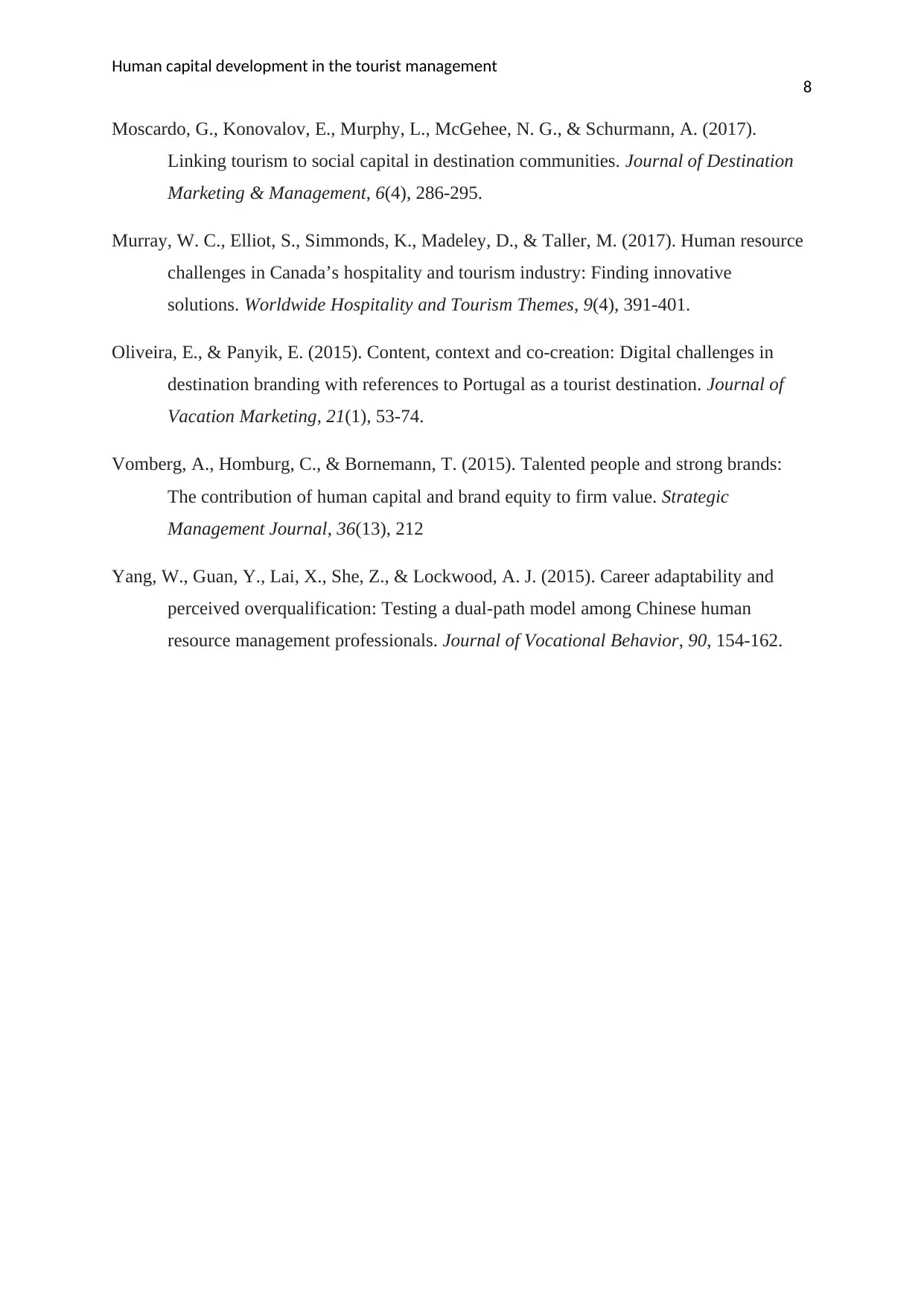
Human capital development in the tourist management
8
Moscardo, G., Konovalov, E., Murphy, L., McGehee, N. G., & Schurmann, A. (2017).
Linking tourism to social capital in destination communities. Journal of Destination
Marketing & Management, 6(4), 286-295.
Murray, W. C., Elliot, S., Simmonds, K., Madeley, D., & Taller, M. (2017). Human resource
challenges in Canada’s hospitality and tourism industry: Finding innovative
solutions. Worldwide Hospitality and Tourism Themes, 9(4), 391-401.
Oliveira, E., & Panyik, E. (2015). Content, context and co-creation: Digital challenges in
destination branding with references to Portugal as a tourist destination. Journal of
Vacation Marketing, 21(1), 53-74.
Vomberg, A., Homburg, C., & Bornemann, T. (2015). Talented people and strong brands:
The contribution of human capital and brand equity to firm value. Strategic
Management Journal, 36(13), 212
Yang, W., Guan, Y., Lai, X., She, Z., & Lockwood, A. J. (2015). Career adaptability and
perceived overqualification: Testing a dual-path model among Chinese human
resource management professionals. Journal of Vocational Behavior, 90, 154-162.
8
Moscardo, G., Konovalov, E., Murphy, L., McGehee, N. G., & Schurmann, A. (2017).
Linking tourism to social capital in destination communities. Journal of Destination
Marketing & Management, 6(4), 286-295.
Murray, W. C., Elliot, S., Simmonds, K., Madeley, D., & Taller, M. (2017). Human resource
challenges in Canada’s hospitality and tourism industry: Finding innovative
solutions. Worldwide Hospitality and Tourism Themes, 9(4), 391-401.
Oliveira, E., & Panyik, E. (2015). Content, context and co-creation: Digital challenges in
destination branding with references to Portugal as a tourist destination. Journal of
Vacation Marketing, 21(1), 53-74.
Vomberg, A., Homburg, C., & Bornemann, T. (2015). Talented people and strong brands:
The contribution of human capital and brand equity to firm value. Strategic
Management Journal, 36(13), 212
Yang, W., Guan, Y., Lai, X., She, Z., & Lockwood, A. J. (2015). Career adaptability and
perceived overqualification: Testing a dual-path model among Chinese human
resource management professionals. Journal of Vocational Behavior, 90, 154-162.
⊘ This is a preview!⊘
Do you want full access?
Subscribe today to unlock all pages.

Trusted by 1+ million students worldwide
1 out of 9
Related Documents
Your All-in-One AI-Powered Toolkit for Academic Success.
+13062052269
info@desklib.com
Available 24*7 on WhatsApp / Email
![[object Object]](/_next/static/media/star-bottom.7253800d.svg)
Unlock your academic potential
Copyright © 2020–2025 A2Z Services. All Rights Reserved. Developed and managed by ZUCOL.





